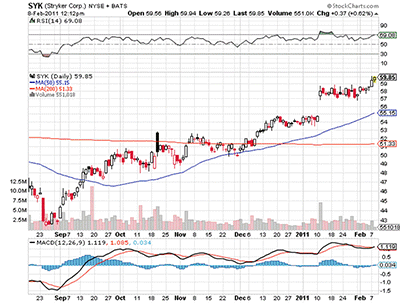Orthopedic implant and medical and surgical equipment provider Stryker (SYK) closed out its year by reporting improving sales and profit growth. Its operations were unexpectedly hit during the recession but are recovering nicely and have great long-term appeal. Moreover, buyout speculation in this space means multiple avenues for high shareholder returns.
Let’s begin with a review of the chart:
Now, from a fundamental perspective, net sales improved 8.6% to $2 billion in the fourth quarter of 2010. Stryker operates two primary divisions, the largest of which is orthopedic implant sales, and it accounted for 58.5% of the total quarterly top line and reported modest 4.5% sales growth. The other division sells equipment for medical and surgical uses and experienced robust growth of 15.3% to account for the rest of sales. Geographically, sales rose 11% domestically to account for over 64% of the total top line, while international accounted for the rest and improved by 5%.
Product cost growth lagged the sales increase and boosted gross margins by 10.5% to $1.4 billion. Research and development (R&D) costs and sales, general, and administrative (SG&A) expenses rose much faster than sales, however, and the quarter included an intangibles expense and impairment charge. This pushed operating income down nearly 25% to $386.4 million. Lower income taxes helped minimize the decrease in the bottom line as net income fell only 3.6% to $295 million, or $0.74 per diluted share.
Year-End Review and Outlook
Full-year sales grew 8.9% to $7.3 billion, gross profit rose 10.9%, and operating income increased 9.8% to $1.8 billion. Net income improved 15% to $1.3 billion, or $3.19 per diluted share. Free cash flow came in at approximately $4.25 per diluted share.
For the coming year, management expects to report sales growth between 11% and 13% and earnings between $3.65 and $3.73 per diluted share. This would represent year-over-year profit growth between 10% and 12%.
Bottom Line
Stryker continues to see a rebound in organic growth trends. The recession surprisingly hit knee, hip, and other joint-replacement surgeries in what used to be seen as a business that was recession-proof. It is also supplementing internal growth with acquisitions, and earlier in January, the company closed on the acquisition of Boston Scientific’s (BSX) neurovascular business that sells “products used for the minimally invasive treatment of hemorrhagic and ischemic stroke.”
At a forward price/earnings (P/E) ratio of just over 15, shares of Stryker are reasonably valued given it has a track record of growing sales and earnings in the double digits. The trailing free cash flow multiple is even more reasonable at about 13.5. Upside exists as sales recover along with the economy and there is also the potential for a buyout.
Recently, Johnson & Johnson (JNJ) was rumored to be interested in acquiring smaller, British-based rival Smith & Nephew plc (SNN). Johnson & Johnson or Medtronic (MDT) could end up being interested in Stryker and both have the financial muscle to carry out such an acquisition. If not, however, company growth trends remain appealingly robust on their own.
By Ryan Fuhrman, CFA, of RationalAnalyst.com






















